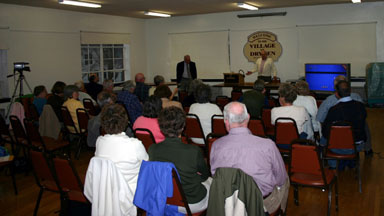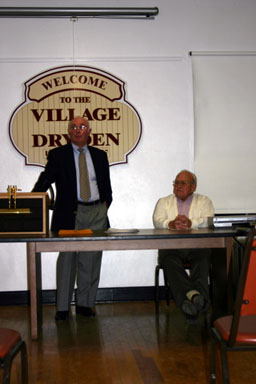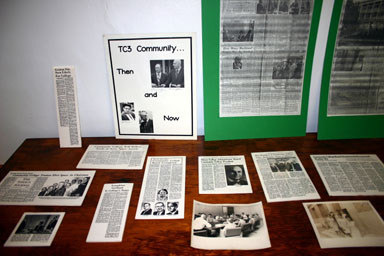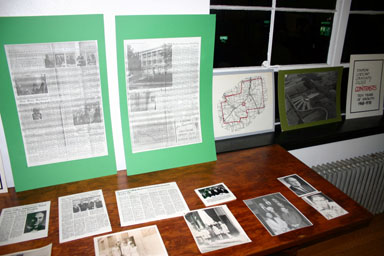April 21, 2004
TC3 memories
Ron Space, the first Chairman of the Board of Trustees of Tompkins Cortland Community College (TC3), gave a presentation to the Dryden Town Historical Association Monday night, shedding some light on how exactly the college came to be, and how it came to be in Dryden.
County Legislator Mike Lane introduced Space, and suggested that that "this union of two counties, this intermunicipal system of education, is one of the best examples of intermunicipal cooperation we have." Lane pointed out that the college now serves 3000 full-time equivalent students, has dormitories for 450 students, and is working on a new round of capital projects to move athletic facilities to a fieldhouse to make room in the main building for classrooms.
Space stepped back to 1964, when thoughts of TC3 were just getting started, introducing Walter Franklin of Cortland County, one of the "instigators" behind the community college, and invited Franklin to come up and speak. The Cortland school district, of which Franklin was superintendent, had been looking at possibilities for a college in the area to address local needs.

Walter Franklin discusses the earliest days of the TC3 idea.
Franklin said that while there were several colleges in the area - Cornell University, Ithaca College, and SUNY Cortland - there was a gap. The nearest community college was in Auburn, a long drive from Cortland. The Cortland group heard that Ithaca was also interested in similar things, though in Ithaca. When the two groups got together, meeting at Groton High School, they looked at formulas for support, but there hadn't been a multi-county college at that point. Smith-Corona especially encouraged them to move forward.
Space picked up the story again at this point, emphasizing the regional battles over the college. While the SUNY master plan encouraged joint projects between counties, that wasn't going to be easy. Tompkins County had twice the population and tax base of Cortland County, and Space said "the City wanted it for itself". There were multiple simultaneous conflicts - between the two counties and between the rural areas and the City of Ithaca within Tompkins County.
Space said that:
"I often feel that the City of Ithaca and the surrounding rural towns are quite different, although they are becoming a lot more similar now. The City of Ithaca prides itself on its own vision, inspiration, etcetera, and I often think that where the city boundaries end and the town begins is where reality begins. The study committee came to the agreement that it should be a two-county project, but there were those in the city especially that wanted it for themselves, and wanted it very strongly, and it showed itself in the final step that came up."
The State University of New York pushed hard for a two-county solution as well, wanting rural counties to get together. Because of its own division, Space said Tompkins County decided Cortland County should vote first, hoping that they might vote it down, so that "we can have it all for ourselves." The vote in Cortland County, in September 1966, was 19-2 in favor, and Tompkins had to vote the next week. The Tompkins County Board of Supervisors split 8-8, with town supervisors voting for and city representatives against. Helen Hoefer, a city representative, changed her vote, and it went through.
The college was approved, but that was hardly the end of the politics. Tompkins and Cortland counties both got to appoint two members to the Board of Trustees, and the governor appointed five members, three from Tompkins County and two from Cortland County. Ron Space was appointed to the board from Tompkins County with a nine-year term, the longest of the original staggered terms. He was the only board member who wasn't from the City of Ithaca or the City of Cortland.
Before the initial board meeting in September 1967, two of the Cortland appointees arrived at Space's house, unannounced, hoping he would consider running for the chairman's position. "I had to decide if I was egotistical enough to vote for myself," said Space, then the youngest of the members (at 36). Why?
"I've always lived in Tompkins County, but being a farmer, we were much more business-oriented toward Cortland County than we ever were to Tompkins County. And it just so happened that my wife... is a Cortland girl. They didn't want the chairman to be from the City of Ithaca. They didn't trust them, and felt it would be unfair."
Space had never met the trustees from Ithaca, but knew several of the trustees from Cortland. In the end, at the meeting, it was a 5-4 vote for "the farmer from McLean". Space was happy with the cooperation he had from the Tompkins County trustees, singling out Robert Sprole of Therm for his help. Helen Hoefer, whose vote made it possible, was also one of the trustees.
Now that the regional battles were largely settled, SUNY focused on getting the board to work together, controversially telling them to meet in private for their first few meetings, much to the fury of the Ithaca Journal. They forged a common vision, put in for a budget, and hired a president. After interviewing five of six candidates on a cold Saturday in January, the board was exhausted, but the sixth candidate, Hushang Bahar, woke them up again, and they hired him. Space described Bahar as "the kind of person you loved or hated, but boy did he make decisions... and if he made a wrong one, wow, would we hear about it."
The next step was finding an interim site. The Agway headquarters on South Hill was an option, but Agway couldn't provide enough room. There was a high school in Ithaca that was possible, but voters turned down funds for a new high school. Smith-Corona owned an old high school in the Village of Groton, though, and offered it to TC3. Smith-Corona gave it to the college, and the Groton school board forgave the mortgage they held on the building.

Ron Space talks about TC3's first building in Groton.
They also had to come up with a name. "South Central Community College" was considered, but the state encouraged "Tompkins Cortland Community College", and students came up with the TC3 abbreviation.
Opening the building meant clearing it out, reorganizing it, finding furniture (SUNY Cortland helped), and hiring faculty. With eight faculty and 150 students, the school opened in Fall 1968.
Now that the school was running, politics could return, as the board looked for a permanent site. It clearly couldn't be in Cortland or in Ithaca, and it had to have public water and sewer. Groton and Dryden were the most viable candidates, and the college asked the communities for proposals. Groton suggested an area on the southeast side of the village, while Dryden suggested both the current Yellow Barn commercial park (where the school board offices are, for now) and the current location of TC3.
The president of the First National Bank of Dryden bought the property, though Space didn't think he'd made anything on the deal. The proposal also considered building the parcel out to 500 acres (from 220) by buying two adjacent parcels. After much heavy lobbying, involving Space's next-door neighbor and college roommate/best man, the Dryden parcel won out, with about 470 points of a possible 500 in the evaluation to the Groton site's 300. Groton was further from Ithaca, which didn't help. The Tompkins County board approved the smaller version of the Dryden site, buying it for $70,000.
In 1974, the college opened a $14 million facility. The state paid half, and the counties were to contribute half, but the counties found $4.5 million in federal funds, and so only had to contribute $2.5 million, split 2-1 between Tompkins and Cortland counties.

Part of the TC3 memorabilia display.
There were a few questions. Gina Prentiss asked about the growing number of students from outside the county. Space guessed that about 70% were still from the county, though also said that Tioga County provides a large number of students. Other counties with students attending make contributions that go to the capital fund of the college. Town Board member and TC3 Director of Information Technology Marty Christofferson noted that out-of-state residents pay double, and that the diversity is "great for the local students."
Someone asked if was a success, to which Walter Franklin said it went way beyond their hopes for the college. Lucille Baker, a professor at TC3, reminisced about the early days of the college when Hugh Bahar's charisma held them together, though faculty meetings were often in uproar, running late, with professors standing on tables. Space said that they sometimes kept Bahar from going to budget hearings and banging on tables.
The night concluded with a video on the college, opening with scenes from the Eight Square Schoolhouse and celebrating the rather different-looking new college. Rod Serling, more famous for The Twilight Zone, narrated, describing TC3 as a "hectic relaxed noisy quiet busy peaceful place... a flexible place in a flexible place."
(The Dryden Town Historical Society recorded the session on both audio and video, so if you'd like more information - this article is just a brief summary - contact them at 607-844-9209.)
Posted by simonstl at April 21, 2004 08:43 AMNote on photos
